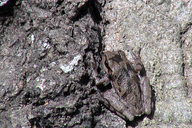|
Hyla femoralis Daudin, 1800
Pine Woods Treefrog Subgenus: Dryophytes | family: Hylidae subfamily: Hylinae genus: Hyla |
|
Taxonomic Notes: Duellman et al. (Zootaxa 2016) treated two major clades as genera; AmphibiaWeb treats these two clades as subgenera(Hyla in the Old World; Dryophytes in the New World and East Asia), thus stabilizing traditional taxonomy. |
|
 © 2002 Brad Moon (1 of 30) |
|
|
Hyla femoralis Bosc, 1800 Joseph C. Mitchell1 1. Historical versus Current Distribution. The historical distribution of pine woods treefrogs (Hyla femoralis) is unknown but may have been larger than today due to the presence of isolated disjunct populations in Alabama and Mississippi (Hoffman, 1988). There is a questionable record from southern Maryland. Pine woods treefrogs occur from the middle Coastal Plain of Virginia, south through most of Florida, except the Everglades, and west to eastern Louisiana. 2. Historical versus Current Abundance. Historical abundance is unknown. Pine woods treefrogs are locally common in most of their range. 3. Life History Features. Aspects of the life history of pine woods treefrogs are in Wright (1932), Harper (1932), and Wright and Wright (1949), but a complete modern synthesis is not available. A. Breeding. Reproduction is aquatic. i. Breeding migrations. Adults migrate from arboreal retreats to breeding sites, but mass migrations have not been reported. ii. Breeding habitat. Breeding sites include depressional wetlands in pine flatwoods, Carolina bays, vernal pools, ditches and other shallow water-filled depressions, and swamps. Pine woods treefrogs are early colonizers and often call from pools in clearcuts and fields. Calling sites are usually on vegetation in and around breeding sites, as high as several meters above the substrate. Large choruses are heard after heavy rains. Calling periods are early April to October in central Florida (Carr, 1940a; Einem and Ober, 1956); March to mid September in Georgia (Harper, 1932; Brandt, 1953); April–August in Alabama (Mount, 1975); early April to mid August in Louisiana (Dundee and Rossman, 1989); April–August in North Carolina (Brandt, 1936a; personal observations); and May–August in Virginia (Mitchell, 1986). Einem and Ober (1956) noted that males stopped calling when a hurricane passed through Florida in 1953. Egg-laying occurs in May–July in North Carolina (Brandt, 1936a; personal observations) and late May to early August in Virginia (Mitchell, 1986). B. Eggs. i. Egg deposition sites. Females lay their eggs attached to vegetation or debris no more than 2–3 cm below shallow water (Wright, 1932; Livezey and Wright, 1947; Mount, 1975). ii. Clutch size. Females lay about 800–2,000 eggs in clusters of about 100 eggs (unpublished data). C. Larvae/Metamorphosis. Larvae may be found from May–September. Wright (1932) reported a larval period of 50–75 d. Metamorphic animals were found early July to mid August in North Carolina (Travis, 1980b) and from 16 June–16 September in Virginia (Mitchell, 1986). SVL at metamorphosis is 11–15 mm (Wright, 1932). Tadpole survivorship in the laboratory was 65–100% (Travis, 1980b). D. Juvenile Habitat. Similar to adult habitat. E. Adult Habitat. Pine woods treefrogs are strongly associated with pine forests, but also may be found in hammocks, swamps, cypress ponds, vernal pools, Carolina bays, mixed hardwood/pine forests, and brackish marshes (Harper, 1932; Duellman and Schwartz, 1958; Neill, 1958a). Pine woods treefrogs climb to the tops of longleaf pines (Carr, 1940a), and seek shelter in cabbage palms, bromeliads, and pitcher plants (Smith and List, 1955; Einem and Ober, 1956). F. Home Range Size. Unknown. G. Territories. Territorial defense is unknown. H. Aestivation/Avoiding Dessication. Unknown. I. Seasonal
Migrations. Pine woods treefrogs do not migrate. K. Interspecific Associations/Exclusions. Pine woods treefrogs are syntopic with oak toads (Bufo quercicus), green treefrogs (Hyla cinerea), barking treefrogs (Hyla gratiosa), bird-voiced treefrogs (Hyla avivoca), little grass frogs (Pseudacris ocularis), American bullfrogs (Rana catesbeiana), Cope's gray treefrogs (Hyla chrysoscelis), Fowler's toads (Bufo fowleri), green frogs (Rana clamitans), southern cricket frogs (Acris gryllus), southern leopard frogs (Rana sphenocephala), eastern spadefoot toads (Scaphiopus holbrookii), spring peepers (Pseudacris crucifer), squirrel treefrogs (Hyla squirella), and narrow-mouthed toads (Gastrophryne carolinensis; Harper, 1932; Wright, 1932; Einem and Ober, 1956; personal observations). Natural and experimental hybrids between Pine woods treefrogs and Cope's gray treefrogs were reported from Alabama, Mississippi, and Texas by Blair (1958a), Pyburn (1960), Pyburn and Kennedy (1961), Mecham (1965), Fortman and Altig (1973, 1974), and Gerhardt (1974c). L. Age/Size at Reproductive Maturity. These life history traits are unknown for any population. M. Longevity. Known longevity in captivity is 4 yr, 5 mo (Snider and Bowler, 1992). N. Feeding Behavior. Pine woods treefrogs prey on grasshoppers, crickets, beetles, caddisflies, ants, wasps, craneflies, moths, and jumping spiders (Carr, 1940a; Duellman and Schwartz, 1958). O. Predators. Known predators include banded water snakes (Nerodia fasciata), black racers (Coluber constrictor), black rat snake (Elaphe obsoleta), common garter snakes (Thamnophis sirtalis), and ribbon snakes (Thamnophis sauritus; Wright, 1932; E.E. Brown, 1979; Palmer and Braswell, 1995). P. Anti-Predator Mechanisms. Adult pine wood treefrogs used the following escape behaviors when placed in enclosures with potential snake predators: flight, remaining motionless, crouching, climbing away, body inflation, walking, and hiding (Marchisin and Anderson, 1978). Tadpoles possess bright coloration, usually red, on the posterior margins of the tail fins and a flagellum, presumably to distract invertebrate predators away from the body (Altig, 1972b; personal observations). Q. Diseases. None reported. R. Parasites. None reported. 4. Conservation. Pine woods treefrogs are locally common in most of their range and are not listed in any state in which they occur. However, several states (Florida, Louisiana, Mississippi, and Virginia) have permit regulations on this and other species regulating the number collected and sold commercially (Levell, 1997). 1Joseph C. Mitchell Literature references for Amphibian Declines: The Conservation Status of United States Species, edited by Michael Lannoo, are here. Feedback or comments about this page.
Citation: AmphibiaWeb. 2024. <https://amphibiaweb.org> University of California, Berkeley, CA, USA. Accessed 21 Nov 2024. AmphibiaWeb's policy on data use. |




 Map of Life
Map of Life